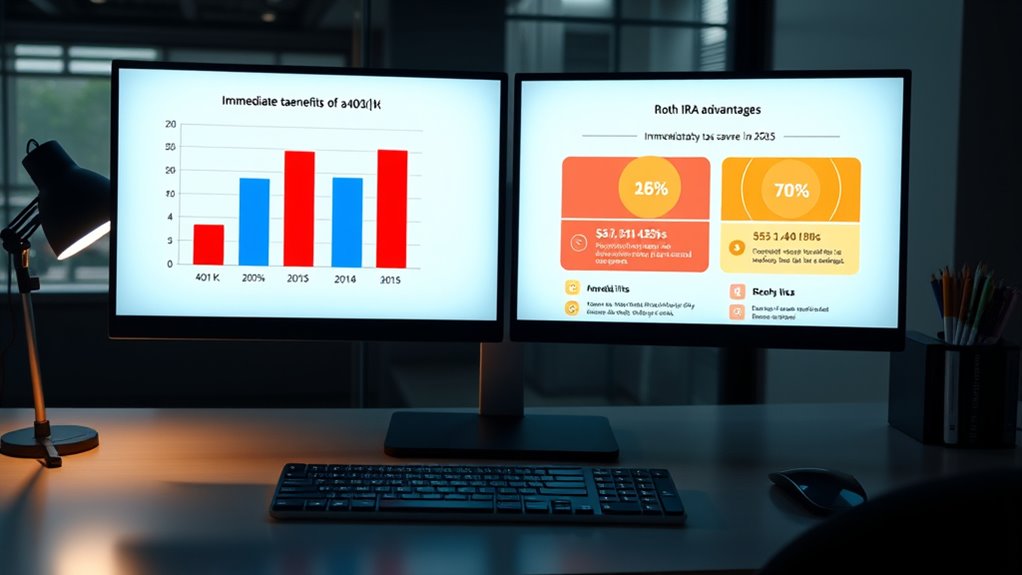If you want to cut your 2025 tax bill now, a traditional 401(k) is often better because contributions are pre-tax, lowering your taxable income immediately. Roth IRAs don’t provide an immediate deduction but offer tax-free growth and withdrawals later. Your choice depends on your current income and future plans. To see which option helps you save more taxes this year and beyond, keep exploring your strategies.
Key Takeaways
- Traditional 401(k) contributions are pre-tax, directly reducing taxable income in 2025, potentially lowering your tax bill more than Roth IRA contributions.
- Roth IRA contributions are after-tax, so they don’t reduce your current tax bill but offer tax-free growth and withdrawals later.
- For immediate 2025 tax savings, a traditional 401(k) generally provides a larger reduction in taxable income than a Roth IRA.
- Roth IRAs do not lower your current year’s taxes; their benefits are realized during retirement through tax-free withdrawals.
- Your choice depends on current income, tax rate, and future expectations, but traditional 401(k)s typically cut your 2025 tax bill more upfront.
How Contributions Affect Your Taxable Income in 2025

In 2025, how you contribute to your retirement accounts directly impacts your taxable income for the year. If you contribute to a traditional 401(k), your contributions lower your taxable income now, providing immediate tax savings. Conversely, Roth IRA contributions are made with after-tax dollars and don’t reduce your current taxable income. While Roth accounts offer tax-free growth, traditional accounts give you an immediate tax benefit. Your estate planning and beneficiary designations also matter—designating beneficiaries ensures smooth transfer of assets, but it doesn’t influence your current tax bill. Understanding these differences helps you optimize your tax strategy today while preparing for future financial security. Balancing contributions between accounts can maximize benefits, but always consider your income limits and long-term tax goals. Knowing the contribution limits and eligibility requirements is essential for effective tax planning, especially when considering retirement account types and their respective advantages.
Comparing Immediate Tax Benefits of 401(k) and Roth IRA

Your immediate tax benefits depend on where you contribute. With a 401(k), your contributions lower your taxable income now, giving you an instant deduction. In contrast, Roth IRA contributions don’t reduce your current taxes, but they set you up for tax-free withdrawals later. Additionally, Roth 401(k)s are available only through employers, so your options may be more limited compared to the broader choices available with Roth IRAs. The contrast in tax treatment reflects the fundamental differences in how these accounts impact your current and future tax obligations.
Tax Deduction Impact
Since 401(k) contributions are made pre-tax, they immediately lower your taxable income for the year, providing a clear short-term benefit. This reduction can help with estate planning by decreasing your current taxable estate and can free up funds for charitable giving. Here’s how the tax deduction impact compares:
- Traditional 401(k) contributions cut your 2025 tax bill by lowering your AGI dollar for dollar, up to the annual limit.
- Roth IRA contributions do not offer an immediate tax deduction, as they are made after-tax.
- Traditional IRA deductions depend on income and participation in employer plans, with limits that affect immediate benefits.
- Higher contribution limits for 401(k)s translate into larger potential tax savings now, unlike IRAs with lower limits and stricter phase-outs.
- Contribution limits for 401(k)s are significantly higher than those for IRAs, allowing for greater immediate tax savings.
- Understanding tax benefits can help you maximize your retirement savings strategy effectively.
Income Reduction Effect
Contributions to a traditional 401(k) are made with pre-tax dollars, which directly lower your taxable income for the year you contribute. This immediate income reduction can help you lower your current tax bill, making it easier to manage estate planning and charitable giving strategies. By reducing your AGI, you may qualify for additional deductions or credits, maximizing your tax benefits now. Plus, the high contribution limits enable significant income reduction, especially useful if you’re looking to lower your taxable estate. However, remember that RMDs start at age 73, which could increase your taxable income later. Roth IRAs, by contrast, don’t reduce your current income, but they offer tax-free growth, beneficial if you expect higher taxes in retirement.
Impact of Contribution Limits on Your Retirement Savings Strategy

Your contribution limits directly influence how much you can save each year and shape your overall retirement strategy. The higher cap for 401(k)s lets you shelter more income, while income restrictions on Roth IRAs may limit your direct contributions. Additionally, IRS sets annual contribution limits for each retirement plan type, which can significantly impact your saving potential. Understanding contribution limits helps you optimize your retirement planning and avoid missing out on valuable tax advantages.
Annual Contribution Cap Differences
How do the differences in annual contribution limits between Roth IRA and Roth 401(k) influence your retirement savings strategy? With Roth 401(k) limits at $23,500 for 2025, you can save substantially more compared to the $7,000 limit for Roth IRAs, or $8,000 if you’re 50+. The higher limits allow you to boost savings quickly, which benefits estate planning and beneficiary designations by building a larger tax-free inheritance. Consider these points:
- Roth IRA caps are strict but offer tax-free growth and flexibility.
- Roth 401(k) limits are higher, maximizing pretax contributions.
- Catch-up contributions enable extra savings for those 50+.
- Using both accounts maximizes tax diversification and estate benefits.
- Implementing vertical storage solutions in your home can free up space for additional savings or investments, illustrating how organization can enhance overall financial planning.
These limits shape your ability to optimize tax advantages and wealth transfer strategies for 2025.
Income Restrictions Impact
Income restrictions substantially influence your retirement savings strategy by shaping which accounts you can contribute to and how much. For example, Roth IRA eligibility depends on your modified adjusted gross income (MAGI), with full contributions possible below certain thresholds. If your income exceeds these limits, your options narrow, pushing you toward traditional IRAs or backdoor Roth conversions. This impacts estate planning, as Roth IRAs offer tax-free growth and tax-free withdrawals, which can be advantageous for heirs. Additionally, your income level affects your Social Security benefits, since higher earnings can increase your benefits but also raise taxes on them. Understanding these income restrictions helps you optimize your contributions, balance tax strategies, and plan effectively for retirement, ensuring you maximize benefits regardless of income level. Income limits can also influence your ability to make catch-up contributions if you’re age 50 or older, allowing you to boost savings as retirement nears. Being aware of income-based contribution limits can help you adjust your savings strategy to maximize your retirement readiness.
Savings Flexibility Options
Contribution limits play a crucial role in shaping your retirement savings strategy by determining how much you can allocate annually to different accounts. With a Roth IRA, the contribution limit remains at $7,000 for those under 50 and $8,000 for those 50+, restricting total annual savings. In contrast, Roth 401(k) contribution limits are considerably higher, allowing up to $23,500 plus catch-up contributions of $7,500 for ages 50-59, and even more for older savers. This higher limit offers greater flexibility for higher earners or late starters.
- Roth IRA contribution limits are fixed and can’t be exceeded.
- Roth 401(k) allows larger contributions, boosting savings potential.
- Catch-up contributions in Roth 401(k) vary by age, enhancing flexibility.
- Employer matches in Roth 401(k) add to total retirement savings.
- Understanding Gold IRA Rollovers can provide additional diversification options for your retirement portfolio.
How Withdrawals Influence Your Tax Bill in Retirement

The way you withdraw funds from your retirement accounts can substantially impact your tax bill during retirement. With a Roth IRA, qualified withdrawals are tax-free, helping you manage your tax bracket and reduce taxes on estate transfers or inheritance considerations. You can withdraw your original contributions anytime without taxes or penalties, but earnings require meeting age and holding period requirements to avoid taxes and penalties. Conversely, traditional 401(k)s and IRAs are taxed as ordinary income upon withdrawal, which can push you into higher tax brackets and increase your tax bills. Early withdrawals often incur penalties, raising costs further. Strategic planning of your withdrawals can help minimize taxes, preserve estate value, and optimize inheritance outcomes, ensuring your retirement savings work efficiently for your financial goals. Proper withdrawal timing can also help you avoid unnecessary taxes and penalties, making your retirement funds last longer. Additionally, understanding RMD rules is essential to prevent costly penalties and ensure a smooth retirement income strategy.
The Role of Income Restrictions in Roth IRA Eligibility

Your income level determines whether you can contribute directly to a Roth IRA, with specific limits for 2025. If your MAGI exceeds these thresholds, your contribution options shrink or disappear, depending on your filing status. Understanding these phaseouts helps you plan your retirement savings strategy effectively. Additionally, IRS income limits are subject to annual adjustments, so staying informed ensures you maximize your retirement contributions within the rules. Being aware of income phaseouts can help you explore alternative strategies like backdoor Roth conversions when direct contributions are limited.
Income Limits for Contributions
Have you ever wondered how income levels influence your ability to contribute to a Roth IRA? Your eligibility depends on your Modified Adjusted Gross Income (MAGI). If your MAGI is under $150,000 (single) or $236,000 (married filing jointly), you can make a full contribution. Between $150,000–$165,000 (single) or $236,000–$246,000 (joint), you’ll be allowed partial contributions. Above these limits, contributions are disallowed, but a Roth conversion might help with tax planning. Keep in mind, income thresholds impact your contribution limits and eligibility, especially if considering traditional IRA conversions. Here’s a quick overview:
- Full contribution under MAGI limits
- Partial contributions within phaseout ranges
- No contributions above phaseout thresholds
- Income determines Roth IRA eligibility and planning options
Impact of Income Phaseouts
Income restrictions play a critical role in determining your eligibility to contribute to a Roth IRA, with specific phaseout ranges that gradually limit your contribution amount as your income rises. The Roth income limits set thresholds for different filing statuses, and the phaseout impact becomes more significant as your modified adjusted gross income (MAGI) approaches the upper limit. For single filers, the phaseout begins at $150,000 MAGI and ends at $165,000, while married filing jointly faces a range from $236,000 to $246,000. Above these limits, your Roth IRA contribution is fully prohibited. The phaseout impacts your ability to contribute directly to a Roth IRA, but it doesn’t affect traditional IRA options. Understanding these income phaseouts helps you plan your retirement contributions more effectively. Additionally, staying informed about income phaseouts can help you identify alternative strategies to maximize your retirement savings within the IRS guidelines.
Employer Contributions and Their Effect on Your Tax Savings

Employer contributions to a 401(k) can substantially boost your retirement savings without reducing your personal contribution limit. These contributions, including employer matching and nonelective payments, are made pre-tax, lowering your taxable income in the contribution year. They grow tax-deferred until withdrawal, when they’re taxed as ordinary income. Keep in mind:
- Employer matching depends on contribution amounts and must meet contribution deadlines.
- Total combined contributions, including employer and employee, are capped at $70,000 in 2025.
- Employer contributions do not reduce your individual contribution limit of $23,500.
- They are always made on a pre-tax basis, even if your contributions are Roth.
- The increased contribution limits in 2025 allow for even higher tax-advantaged savings opportunities for employees and employers alike.
Understanding this helps you maximize tax savings by combining employee contributions with employer matches, boosting your overall retirement funds.
Flexibility in Accessing Funds and Its Tax Implications

When it comes to accessing your retirement funds, the flexibility offered by Roth IRAs and 401(k)s varies markedly. Roth IRAs let you withdraw contributions anytime without taxes or penalties, providing quick access for emergencies or estate planning needs. Earnings, however, require age 59½ and a five-year holding period to avoid taxes and penalties; early withdrawals may trigger costs unless exceptions apply. 401(k)s often permit loans or hardship withdrawals, offering more immediate access but with plan-specific rules and potential taxes or penalties. Unlike Roth IRAs, 401(k)s have Required Minimum Distributions (RMDs) starting at age 73, limiting flexibility during retirement. Beneficiary designations also influence estate planning, affecting how easily funds transfer upon death and the associated tax implications. Additionally, Roth IRAs do not have RMDs during the owner’s lifetime, allowing for more control over your retirement funds.
Investment Choices and Their Potential to Maximize Tax Advantages

Your choice of investment options within Roth IRAs and 401(k)s can considerably influence your long-term tax advantages. By selecting a mix of investments, you can achieve effective investment diversification, which helps manage risk and optimize growth potential. Combining Roth and traditional accounts offers a diversified tax strategy, balancing taxable and tax-free income streams in retirement. Roth IRAs and Roth 401(k)s grow tax-free, reducing your taxable income later. Proper planning also enhances estate planning benefits, as heirs can inherit assets that continue to grow tax-free. Consider these strategies:
- Diversify investments to maximize growth and tax efficiency
- Use Roth accounts for tax-free growth and withdrawals
- Combine account types for a flexible tax strategy
- Leverage estate planning benefits to pass on tax-advantaged assets
How Early Withdrawals Can Affect Your Tax Situation

Early withdrawals from retirement accounts can substantially impact your tax situation, often leading to unexpected costs. Early withdrawal penalties, such as a 10% IRS penalty, apply if you take money out before age 59½, unless you qualify for specific exceptions like medical expenses or a first-time home purchase. For Roth IRAs, earnings withdrawn early may be taxed and penalized unless the account has been open for over five years or other exceptions apply. Roth IRA conversions add another layer, as early withdrawal penalties can apply to converted amounts within five years unless you meet certain exemptions. In traditional IRAs, early withdrawals increase your taxable income and can trigger penalties, raising your overall tax bill for 2025. Planning withdrawals carefully helps avoid unnecessary penalties and minimizes your tax impact. Additionally, you can avoid penalties by meeting specific criteria such as disability, first-time home purchase, or substantial equal periodic payments.
Strategies to Optimize Your Tax Savings With Retirement Accounts

Maximizing your tax savings with retirement accounts requires strategic planning around contribution types, income limits, and withdrawal rules. To optimize benefits, consider balancing tax-deferred growth with future tax savings, especially for estate planning and investment diversification. Use these strategies:
- Contribute to a 401(k) to lower current taxable income and benefit from employer matches.
- Maximize Roth IRA contributions if your income allows, for tax-free withdrawals and no RMDs.
- Leverage traditional IRAs for potential tax deductions, depending on your income and participation in employer plans.
- Select a diverse investment mix within your accounts to minimize risks and future tax liabilities.
- Understanding the tax implications of each account type can help you tailor your strategy to your current and future financial situation. Tax implications influence how you allocate contributions between accounts for optimal savings.
Aligning contributions with your income, future tax outlook, and estate planning goals ensures you maximize savings and flexibility in retirement.
Frequently Asked Questions
Can I Contribute to Both a Roth IRA and a 401(K) Simultaneously?
Yes, you can contribute to both a Roth IRA and a 401(k) simultaneously, which is a smart move for your retirement planning and investment strategies. This allows you to maximize savings, benefit from different tax advantages, and diversify your retirement income sources. Keep in mind that each account has its own contribution limits and eligibility rules, especially for the Roth IRA based on income, so plan accordingly to optimize your savings potential.
How Do Roth IRA Conversions Impact My Current Tax Bill?
Your current tax bill can take a hit when you do a Roth IRA conversion—think of it as opening Pandora’s box. The timing of your conversion matters; if you convert when you’re in a lower tax bracket, you save. But a big conversion in a high tax year can push you into a higher bracket, increasing taxes owed. Strategic conversion timing helps you balance the tax impact now and in the future.
Are There Penalties for Withdrawing Earnings Early From a Roth IRA?
When you make an early withdrawal from your Roth IRA, you may face a penalty tax on earnings if you’re under 59½ and haven’t met the 5-year rule. The penalty tax is usually 10% on those earnings, unless you qualify for an exception like a first-time home purchase or disability. Contributions can be withdrawn anytime without penalty, but earnings are subject to these rules to avoid penalties and taxes.
Does My Age Affect the Tax Benefits of a Roth IRA Versus a 401(K)?
You might worry that age restrictions or contribution limits limit your options, but your age actually influences the tax benefits of Roth IRAs and 401(k)s. Younger people benefit from longer tax-free growth, while older investors can maximize catch-up contributions. Roth IRAs offer tax-free withdrawals after 59½, ideal if you’re early in your career. In contrast, 401(k)s with higher limits help those closer to retirement lower current taxes and grow savings efficiently.
What Are the Tax Implications of Rolling Over a 401(K) Into a Roth IRA?
When you roll over a 401(k) into a Roth IRA, you convert pre-tax funds into a tax-free growth account. The rollover triggers income tax on the converted amount, so your conversion timing matters—doing it in a year with lower income can reduce taxes. Planning the timing carefully helps you avoid pushing into higher tax brackets and maximizes the benefit of tax-free growth in your Roth IRA.
Conclusion
Ultimately, choosing between a 401(k) and a Roth IRA is like planting seeds in different soils—each offers unique growth. By understanding their tax benefits and limitations, you can craft a strategy that helps your savings flourish come 2025. Think of your retirement plan as a garden—careful choices now will harvest a bountiful, tax-advantaged future. Make your move wisely, and watch your financial landscape bloom.









